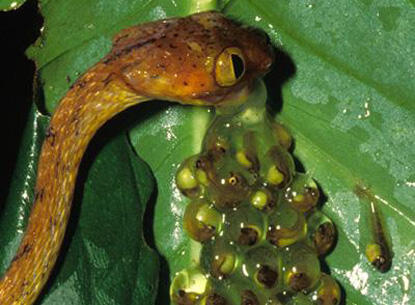
April 29, 2011
Fear, Death and Life History of the Red-Eyed Tree Frog
VCU biologists examine how predation and perception of predation risk is shaping prey life history in important ways and linking food webs across ecosystems
Share this story
Predators eat things. This is the fundamental trophic interaction upon which food webs are built and has been an important focus of ecological research for decades.
While ecologists have long known that predators have an important effect on prey populations, they are now learning that there’s more to this relationship than originally thought.
Scientists, including researchers at Virginia Commonwealth University, are coming to appreciate that predators not only eat prey, but that they also “scare” them – and perception of predation risk can induce prey to change their behavior, body shape, color and activity levels.
For organisms with complex life cycles that change habitats and ecology through development, such as most animals from butterflies to frogs, perceived predation risk can also induce prey to alter the timing of critical life history switch points, like when to hatch or when to metamorphose.
“Predators shape prey population, life history and communities not only through their lethal effects, such as eating them, but through non-lethal effects. We’re becoming aware now that this trend could be as important, and in some cases more important, than the fact that predators eat prey,” explained James Vonesh, Ph.D., an assistant professor of biology at VCU, who has published several studies on the impact of fear on ecosystems.
“This creates an interesting situation in which the effects of predators early in the life cycle can cascade into later life stages to alter interactions between prey and later predators and competitors,” said Vonesh, who specializes in the study of amphibian life.
“By eating prey in early stages they reduce the number of prey making it into later stages. By scaring them, that can induce them to make the transition earlier than they might have otherwise, perhaps at a smaller or less developed stage. Both these effects can change ecology in later life stages.”
From tree to water, and back again
In a recent study, published online April 27 in the Ahead of Print section of the journal The American Naturalist, Vonesh, together with a team of researchers from VCU, the Smithsonian Tropical Research Institute in Panama, the University of Florida and Boston University, explored how tadpole density and tadpole size affects predation rate in the pond. The team has been examining the natural life history of the red-eyed tree frog found in the rain forests of Panama.
Red-eyed tree frogs have a fascinating and complex life history. They place their eggs on leaves above tropical ponds where they may be attacked by egg predators such as tree snakes, wasps and pathogenic fungi. These predators eat some eggs, but they also induce other eggs to hatch early to escape predation. This was first discovered by Vonesh’s colleague, Karen Warkentin, Ph.D., co-lead investigator of this study and associate professor of biology at Boston University. However, according to Vonesh, hatching early comes at the cost of being less developed and more vulnerable to predators that they’ll face in the pond. Predators in the pond in turn shape the number and size of froglets that metamorphose out of the pond and climb back into the trees.
“To fully understand how the red-eyed tree frog’s predators shape its life cycle, we need to understand how egg predator effects on the number and size of tadpoles entering the pond translate through the tadpole stage to metamorphosis under different aquatic environments - for example, ponds with certain kinds of predators, or high versus low resources,” Vonesh said. “Our new research paper is a critical step in accomplishing that.”
This study uses short experiments to inform mathematical models that predict how the effects of egg predators on tadpole abundance and size play out in different pond environments.
“The study provides us with a quantitative framework for predicting how the lethal and non-lethal effects of egg predators play out through the tadpole stage to metamorphosis - focusing on the fact that tadpole predation depends upon both the abundance of prey and their size,” he said.
Vonesh and his team will continue to investigate the interplay between resources, prey growth and size dependent predation risk and its effects on survival and life history of the prey and other effects throughout the aquatic community.
Vonesh and Warkentin worked with Michael McCoy, Ph.D., first author of the paper and postdoctoral researcher at VCU, and Benjamin M. Bolker, Ph.D., professor at McMaster University in Hamilton, Canada.
The research was supported by a grant from the National Science Foundation.
Subscribe to VCU News
Subscribe to VCU News at newsletter.vcu.edu and receive a selection of stories, videos, photos, news clips and event listings in your inbox.







